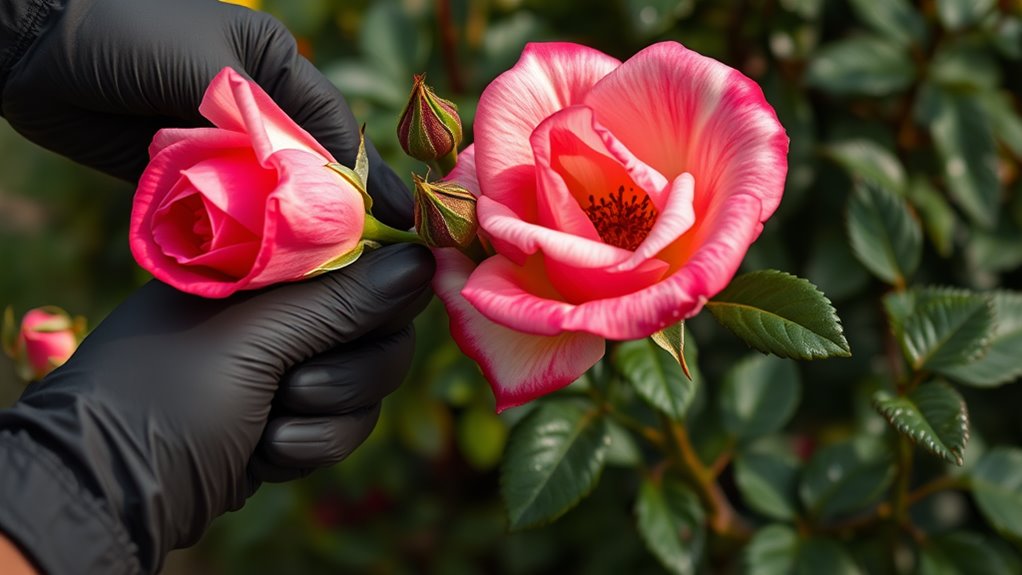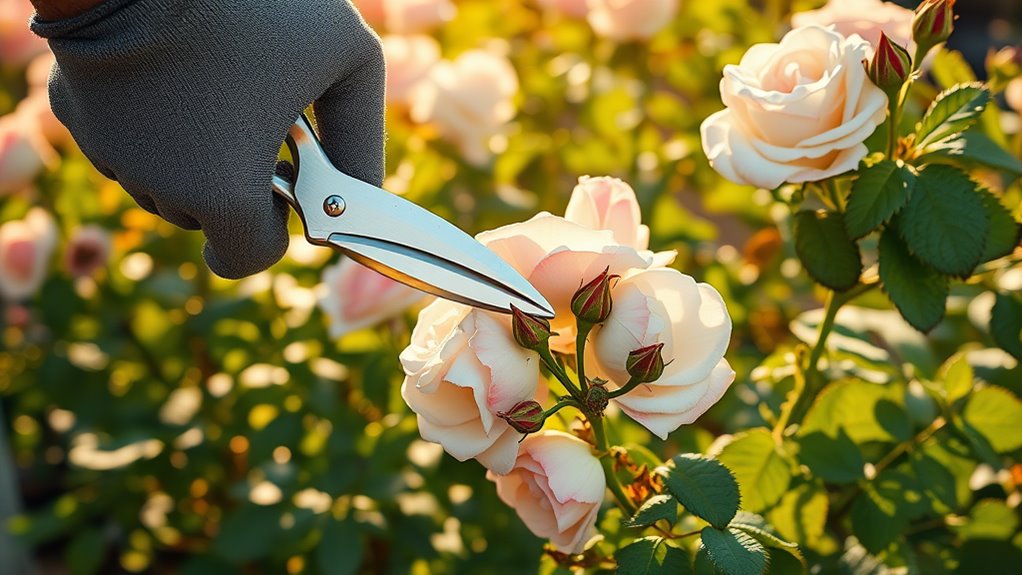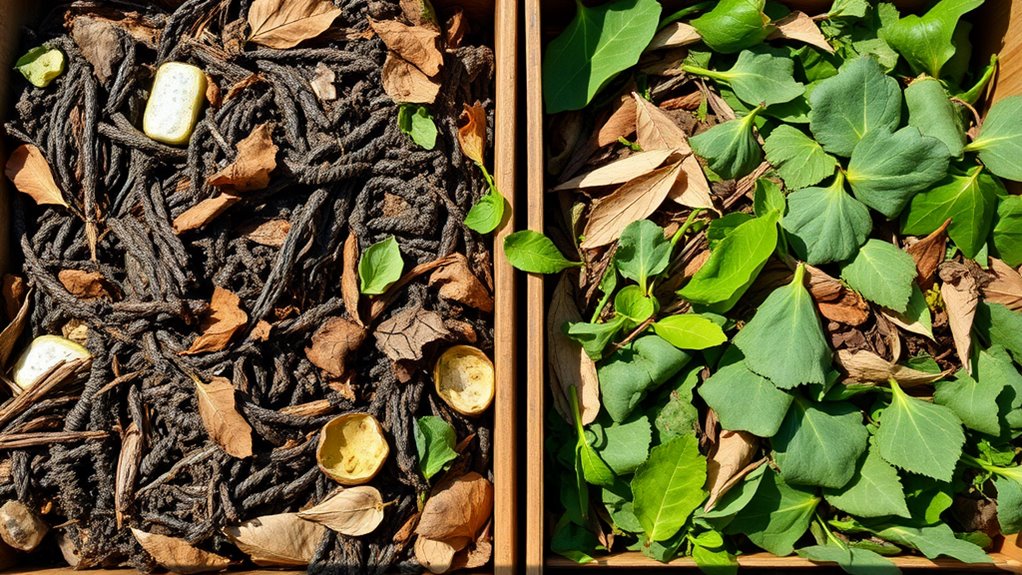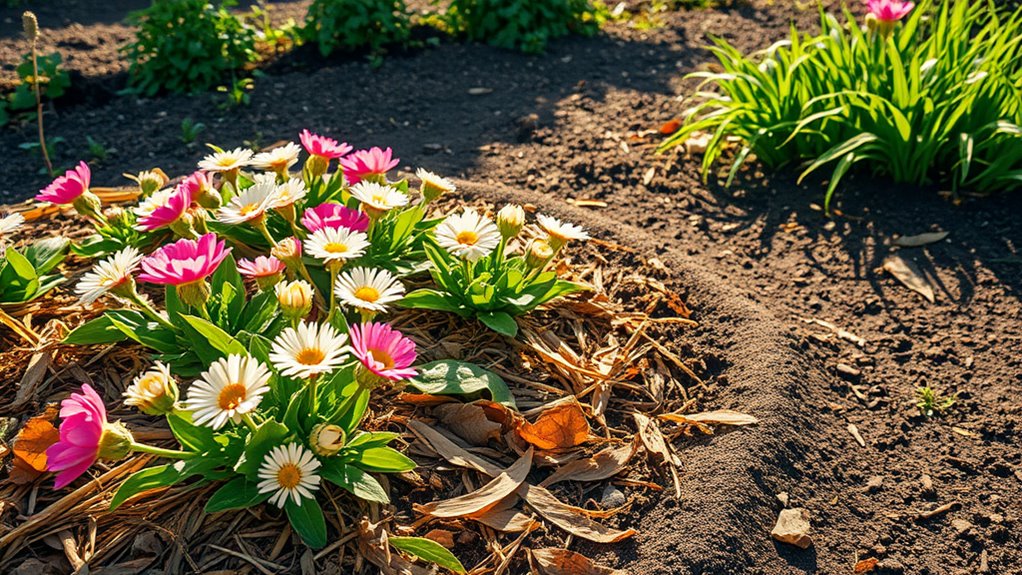Why Deadheading Might Be the Secret to a Longer Bloom
Deadheading is your secret weapon for extending blooms: by snipping off faded flowers, you’re redirecting the plant’s energy from seed production to fresh growth, which boosts flower output and encourages reblooming in annuals like petunias and perennials like coneflowers. It’s a simple, practical technique that enhances garden vitality and delays seed set for longer displays. Master this, and you’ll uncover more ways to transform your garden’s performance.
Key Takeaways
- Deadheading redirects plant energy from seed production to new blooms, extending flowering periods.
- It encourages bushier growth and boosts flower production in annuals like petunias and perennials like coneflowers.
- Regular deadheading delays seed set, allowing plants to focus on producing more vibrant flowers.
- Removing faded blooms stimulates fresh bud formation, leading to prolonged and repeated blooming cycles.
- Consistent deadheading, timed every 3-10 days, enhances overall plant health and maximizes bloom duration.
What Is Deadheading and How It Works
When you deadhead your plants, you’re simply removing the faded or dead flowers to redirect the plant’s energy from seed production to new blooms. Additionally, it can result in more abundant blooms throughout the growing season.
This flower care hack involves using sharp, clean pruners to snip just above a leaf node or set of leaves, promoting healthier growth. You identify spent blooms by their wilted petals and seed pods forming.
For annuals and perennials, deadheading encourages bushier plants; pinch smaller flowers by hand to avoid damage.
Timing matters—do it regularly during peak bloom season for optimal results, making it a practical tool in your gardening arsenal.
By adopting an efficient deadheading routine like the one session per week method, you can save time while ensuring your flowers remain vibrant and healthy.
Key Benefits of Regular Deadheading
When you regularly deadhead your plants, you’ll extend their bloom time by redirecting energy from seed production to new growth.
This technique boosts flower production, allowing you to cultivate a more abundant display in your garden, and it incorporates practical techniques that enhance overall plant health for enthusiasts.
Additionally, deadheading serves as one of the essential flower care hacks to achieve vibrant blooms throughout the season.
Extended Bloom Time
Regular deadheading redirects your plant’s energy from seed production to new flower buds, effectively extending bloom time. This technique keeps your garden vibrant longer by preventing early dormancy and promoting continuous growth cycles.
You’ll maintain a lively display through the seasons with minimal effort.
-
Delay seed set: Remove faded flowers to halt the plant’s natural end-of-bloom phase, adding weeks to your display.
-
Encourage reblooming: For perennials, regular deadheading triggers new bud formation, sustaining color in your landscape.
-
Adapt to weather: In variable climates, this practice helps your plants recover from stress, prolonging overall bloom duration.
Increased Flower Production
Boost your garden’s flower production by deadheading spent blooms consistently.
When you remove faded flowers, the plant redirects energy from seed production to new bud formation, stimulating more vigorous growth and additional blooms. This process enhances lateral branching, increasing the number of flowering sites on plants like petunias and roses.
Technically, it interrupts the plant’s reproductive cycle, prompting hormonal responses that favor vegetative and floral development.
Practically, use sharp shears for clean cuts above leaf nodes to minimize disease risk; you’ll see a 20-50% boost in flowers, creating a fuller, more vibrant garden display.
Step-by-Step Techniques for Deadheading
To effectively deadhead your plants and extend their blooming period, you’ll start by identifying spent flowers that have faded or wilted. Examine each plant closely for discoloration or drooping, then prepare sharp pruners to make precise cuts. This technique boosts energy for new blooms while maintaining vigor. For optimal results, consider this practice as part of a pruning methodology that supports overall plant health and vitality as described in effective gardening guides.
Follow these steps for best results:
-
Sterilize tools first: Wipe pruners with alcohol to avoid spreading diseases, ensuring clean, infection-free cuts that promote healing.
-
Cut at the right spot: Snip the stem just above a leaf node or bud using firm, even pressure to stimulate fresh growth without damaging tissue.
-
Dispose properly: Remove deadheaded flowers immediately and compost them, preventing pest attraction and keeping your garden tidy.
Deadheading is one of the essential pruning techniques that can significantly enhance the growth rate of your garden plants.
Ideal Plants for Deadheading Practices
You can maximize your garden’s flowering potential by selecting ideal plants for deadheading, starting with the best annuals that encourage repeated blooms.
These annuals, like petunias and marigolds, respond quickly when you remove spent flowers to promote new growth.
Next, explore top perennials such as coneflowers and salvia, which sustain longer displays through your regular deadheading efforts.
To enhance your flower bed maintenance, consider implementing practical tips from reliable gardening guides for even better results.
Best Annual Plants
While deadheading removes spent flowers to encourage repeat blooming, the best annual plants for this practice include easy-to-maintain varieties like petunias, marigolds, and zinnias, which respond quickly and produce vibrant, extended displays with regular pruning.
You’ll find these plants thrive under your care, boosting garden vitality through precise techniques.
-
Petunias: Pinch off wilted blooms daily using sharp shears to stimulate prolific reblooming and maintain compact growth.
-
Marigolds: Snip faded flowers weekly at the stem base to redirect energy from seeds to fresh buds, enhancing pest resistance.
-
Zinnias: Cut dead heads regularly just above a leaf node to promote bushier plants and longer-lasting color displays.
Top Perennial Choices
Perennials such as daylilies and coneflowers thrive with deadheading, redirecting energy from faded blooms to extend flowering seasons and enhance garden resilience.
You should add salvia to your list, as its regular deadheading encourages nonstop flowering and denser growth.
Black-eyed Susans reward you with repeated blooms when you snip spent flowers promptly.
For phlox, deadheading curbs seed production and boosts vigor, while bee balm benefits from precise cuts that prevent disease.
Use sharp pruners for clean snips above leaf nodes; this practice maintains plant health and maximizes your garden’s longevity and beauty.
Timing and Frequency for Optimal Results
Achieving optimal blooms requires timing deadheading correctly, as plants respond best when faded flowers are removed before they set seed. This redirects energy to new buds, extending your garden’s display. Incorporating pruning techniques can further enhance overall plant vitality and support sustained blooming.
Tailor frequency to plant type and season for practical results.
-
Time it right: Start deadheading as soon as flowers fade, ideally in the morning to minimize stress and promote quick recovery.
-
Set a routine: Deadhead every 3-10 days during peak bloom, adjusting based on growth rates to sustain flowering.
-
Monitor progress: Check plants weekly for reduced vigor, then increase frequency to maintain health and encourage reblooming.
Remember, gardening myths can often mislead, so focus on evidence-based techniques to maximize your plant’s potential.
Tools and Materials for Effective Deadheading
To deadhead effectively, you’ll need just a few essential tools: sharp pruning shears for clean cuts, durable gloves to protect your hands, and a small container for collecting clippings.
When picking pruning shears, opt for bypass types to minimize stem damage; sharpen them regularly with a stone for precision and hygiene.
Choose gloves made from flexible, puncture-resistant materials like leather to handle thorny plants safely without losing dexterity.
For the container, select a lightweight, lidded option to contain debris, prevent pest spread, and keep your workspace tidy.
Always inspect and clean tools after each use to ensure they perform optimally and last longer.
Combining Deadheading With Other Garden Hacks
While deadheading encourages more blooms, you’ll boost your garden’s vitality by integrating it with other hacks like mulching or pruning. This synergy optimizes plant resources, prevents disease, and sustains energy for prolonged flowering. Additionally, mulching supports pest control by creating a barrier that deters common garden pests, as demonstrated in transforming weed-ridden areas into thriving oases.
To maximize results, follow these steps:
-
Mulch post-deadheading: Apply a 2-3 inch layer around plants to retain moisture, regulate soil temperature, and suppress weeds, reducing plant stress.
-
Prune strategically: Cut back deadheaded stems to healthy buds using sharp shears, improving air circulation and directing energy to new growth.
-
Incorporate watering techniques: Adjust irrigation to deep, infrequent sessions after deadheading, ensuring roots absorb nutrients efficiently without overwatering.
Enhance your mulching efforts by exploring different mulch types that can transform your garden’s growth and size.
Tracking Bloom Improvements After Deadheading
Once you’ve deadheaded your plants, you’ll want to track bloom improvements to gauge the technique’s effectiveness.
To do this, establish a baseline by counting initial blooms and noting plant health, such as leaf color and size. Weekly, record new bud formations, full bloom dates, and flower longevity using a simple journal or app.
Compare deadheaded plants with untreated ones to quantify differences in bloom frequency and duration. Track environmental factors like sunlight and watering to isolate deadheading’s impact.
After four to six weeks, analyze the data to see if blooms last longer, enabling precise tweaks to your routine for optimal results. For enhanced garden vitality, consider incorporating companion planting methods to further support plant growth and pest management.





